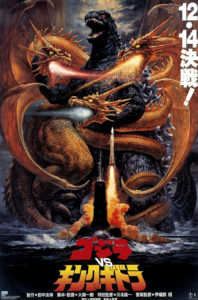Director: Kazuki Omori
Cast: Kosuke Toyohara, Anna Nakagawa, Megumi Odaka, Katsuhiko Sasaki, Akiji Kobayashi, Yoshio Tsuchiya, Robert Scott Field, Richard Berger, Wataru Fukuda
Running Time: 103 min.
By Ian Whittle
To paraphrase the great Professor Farnsworth: “Never take lessons in not-changing-history from a man who is his own grandpa!”
Godzilla vs King Ghidorah is the third film in the Heisei series, following on from The Return of Godzilla (1984) and Godzilla vs. Biollante (1989). The films in this series are sequels to the original 1954 Godzilla, but ignore all the Showa films made between 1955’s Godzilla Raids Again and 1975’s Terror of Mechagodzilla. Which means that in this series, this is the first appearance of Godzilla’s notorious foe King Ghidorah, a three headed monster who had originally appeared in Ghidorah the Three-Headed Monster (1964) and several other Showa films.
And if you think that’s complicated, wait until you hear the plot!
In 1992, a UFO that looks suspiciously like the USS Enterprise lands outside Tokyo. Its main occupants are an American man (Chuck Wilson), a Russian man (Richard Berger) and a Japanese woman (Anna Nakagawa), all of whom speak with bizarre Aussie/American accent hybrid accents in the English dub of course. They speak with the Japanese government and explain they come from the 23rd Century, where Japan is an atomic wasteland following an attack from Godzilla. The people from the future, known as the Futurians in some circles, has found a book by sci-fi author Terasawa (Kosuke Toyohara) that theorises Godzilla was a dinosaur contaminated by the H-Bomb test at Bikini in 1954. The Futurians plan: to time-travel to 1944, remove the pre-atomic Godzilla from his island home and teleport him to the sea far away from the atomic test 10 years later.
Well, at least that’s the official plan…
So the Futurians teleport back to 1944, taking Terasawa, palaeontologist Masaki (Katsuhiko Sasaki) and ESP researchers Miki Saegusa (Megumi Odaka) with them. It’s barely referenced in this movie, but the previous entry Godzilla vs Biollante had established Miki as having a strong psychic connection to Godzilla. If, like me, you didn’t see Biollante (which didn’t get a UK video release back in the day and, in fact, still hasn’t), this weird psychic stuff comes completely out of left-field when about an hour into this film they suddenly have Miki explain her connection to the Big G (which I dare say has inspired some rule 34 nonsense on the Dark Web, and no, I haven’t looked).
In ’44, we are subjected to some bizarre “acting” from American soldiers witnessing the Futurians’ time-travel ship…one of whom is called Major Spielberg! And I know Back to the Future did this with the Chuck Berry gag, but I really dislike time travel movies suggesting all great contributions to culture come from the influence of time travellers. It’s worse than all those ancient alien astronaut “documentaries” on the History Channel! A pre-atomic Godzilla (looking more like a conventional T-rex than usual) attacks the US soldiers and inadvertently saves a Japanese garrison led by Shindo (Yoshio Tsuchiya), who in 1992 is a millionaire industrialist who looked far too old to be a commander in 1944, but doesn’t seem to have aged much since then! (And ironically, the 60+ Tsuchiya was too young to have been a commander in 1944!)
Godzilla vs King Ghidorah didn’t get released in the USA until 1998 (for a change, the UK got it first!), but footage of Godzilla fighting the US troops caused a stir on some US news networks in 91/92 with veterans apparently up in arms (heh, heh) about it. And I must say I’d have loved to have been a kid in the early 90s seeing footage from an unknown Godzilla movie on the six o’clock news!
So Godzilla is out of the way of the Bikini blast BUT…the Futurians leave behind three little reptile creatures (who look nothing like Mogwais or Gremlins, your Honour) called Dorats on the island. And for some reason that is barmy even by this series’ standards, this means that in 1992, the Futurians can attack Japan (including, rather alarmingly, Hiroshima) with a three-headed flying dragon called King Ghidorah! Why, you ask? Well, Godzilla didn’t destroy Japan, it became a world superpower instead (boy, 1991 was a long time ago you say?), and the Futurians are out to prevent that. And now Godzilla is gone, King Ghidorah is to destroy Japan…
…except there’s another Godzilla after all (because you know, timey-wimey stuff) so FIGHT FIGHT FIGHT!
And I didn’t even mention the Futurians’ android M-11 (Robert Scott Field) who is of course not meant to resemble the Terminator in any way, your honour (hmm, let’s hope Harlan Ellison didn’t see this!), and who runs in a very silly manner!
For such a ludicrously nonsensical plot, one that can’t even be bothered to address any number of time paradoxes it raises, Godzilla vs King Ghidorah is buoyed by a delirious sense of enthusiasm that is rather catching. It shamelessly throws numerous derivatives of various recent Hollywood blockbusters at the screen, but also seems to really understand the pop-cultural and archetypal importance of its two main monsters (even King Ghidorah’s silly new origin is an insult to anyone who takes this stuff at all seriously). The effects run hot and cold, the actors seem lost, and the film’s dubious take on time-travel, history, economics, what-have-you is dubious to say to the least…but I defy you not to have fun watching it!
And with veteran composer Akira Ifukube returning to the series after a long absence, this definitely ranks highly as one of my all time favourite Japanese movies.
Ian Whittle’s Rating: 8/10



